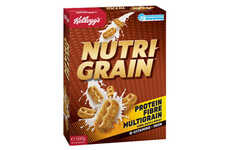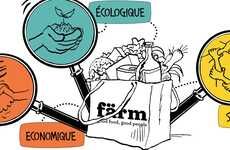
Finances Online's Infographic Reveals Who Controls Our Food
Megan Facciuolo — June 4, 2014 — Lifestyle
References: comparisons.financesonline & designtaxi
Created by Finances Online, this infographic sheds light on the food industry and just how small it really is. There are thousands of products for sale at your local grocery store, but surprisingly, most of them originate from one or two giant corporations. A 2013 study by the Food and Water Watch examined the market share of 100 common grocery items and found a disturbing pattern: shoppers will come home with bags of groceries, but they are really only purchasing products from 2-4 companies.
For example, Kraft owns majority of the cheeses, coffees and fruit drinks on the market, while PepsiCo. owns over 80% of the chip brands sold in stores in North America. Some more surprising information that the infographic reveals is the fact that Mars chocolate actually owns more than the Mars Bar; it owns M & Ms, Twix, 3 Musketeers and Snickers.
For example, Kraft owns majority of the cheeses, coffees and fruit drinks on the market, while PepsiCo. owns over 80% of the chip brands sold in stores in North America. Some more surprising information that the infographic reveals is the fact that Mars chocolate actually owns more than the Mars Bar; it owns M & Ms, Twix, 3 Musketeers and Snickers.
Trend Themes
1. Consolidation of Food Brands - With a few giant corporations controlling a majority of food products, there is an opportunity for disruptive innovation in creating and promoting independent, niche food brands.
2. Transparency in Food Industry - The revelation about the limited number of companies behind common grocery items highlights the need for greater transparency in the food industry, presenting opportunities for disruptive innovation in the form of blockchain technology or traceability solutions.
3. Shift Towards Local Food Production - The dominance of a few corporations in the food industry opens up opportunities for disruptive innovation in localized food production, such as urban farming or community-supported agriculture models.
Industry Implications
1. Food Manufacturing - The concentration of food products under a few corporations presents an opportunity for disruptive innovation in the food manufacturing sector, such as developing alternative production methods or novel ingredients.
2. Grocery Retail - Greater awareness about the control of food brands by a handful of companies can drive disruptive innovation in the grocery retail industry, fostering the growth of independent, locally-owned stores or online platforms focusing on niche products.
3. Food Technology - The lack of diversity in the food industry calls for disruptive innovation in food technology, including the development of novel processing techniques or sustainable packaging solutions that can challenge the dominance of major corporations.
3.3
Score
Popularity
Activity
Freshness























